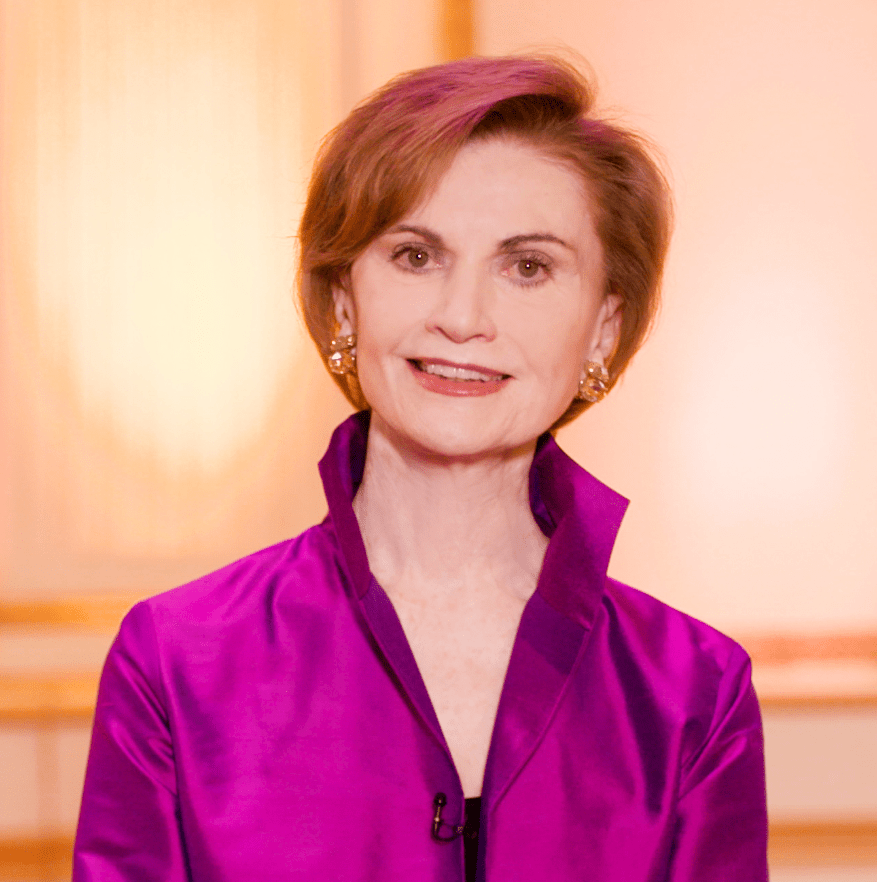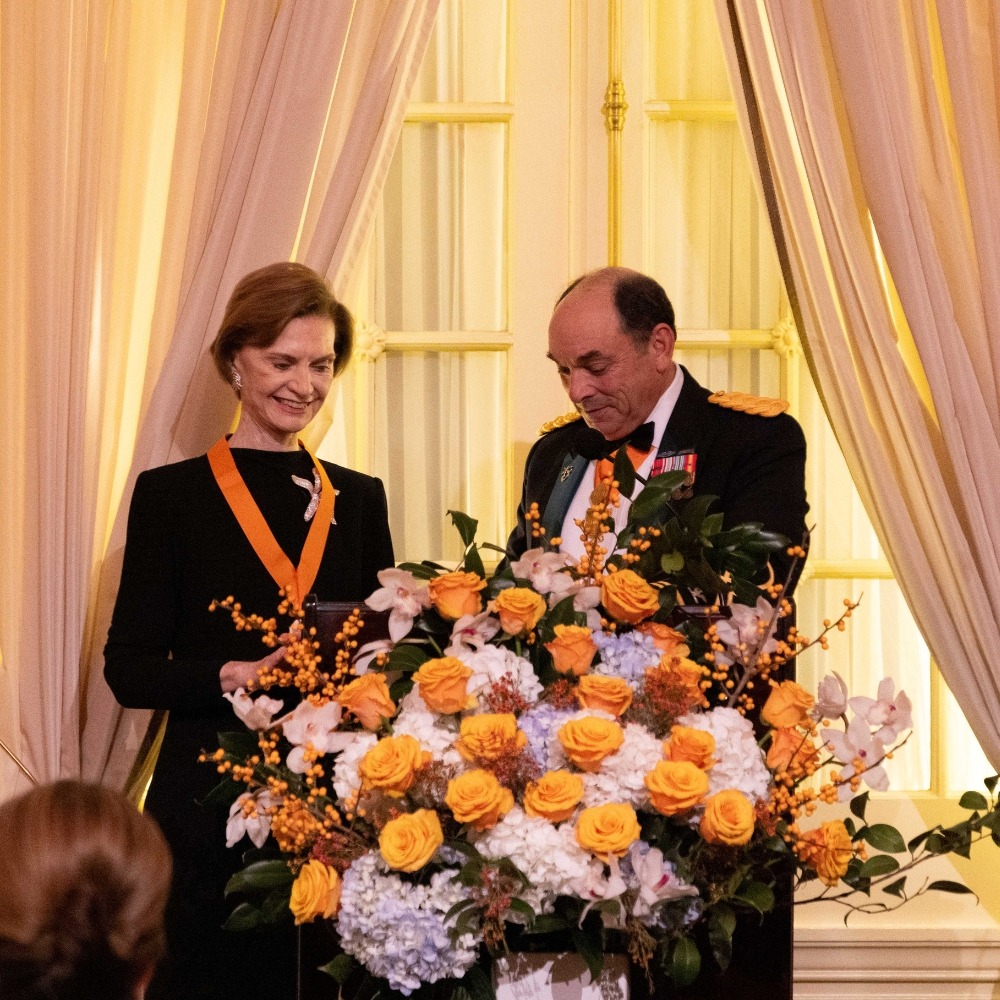Above: Sarah Bogart Cooney, Jonathan Doucette, Adrian Bogart, Peg Breen, Sally Quackenbush Mason and David Nostrand
Interview with Peg Breen, President of the New York Landmark’s Conservancy
Peg Breen, President of the New York Landmarks Conservancy, will be the recipient of the 2023 Gold Medal for Distinguished Contributions to the City of New York at the Holland Society of New York’s 133rd Dinner Dance.

Peg Breen grew up in a house her great-grandfather built in upstate Glens Falls after the Civil War. She has always loved old buildings and the history and stories they hold. She has a B.A. in Journalism and an M.A. in American Studies. After working in public television and at City Hall, she joined the Conservancy in 1994. She is constantly energized by the people and issues the Conservancy deals with the ability to help save the buildings and neighborhoods that matter to New York. Her favorite projects include promoting the stabilization of the South Side of Ellis Island; saving the “Survivors Staircase” after 9/11 which is now featured in the 9/11 Museum; helping non-profits recover after Superstorm Sandy; initiating our Sacred Sites Open House Weekend; steadfastly supporting the Moynihan Train Hall, and saving the Picasso Curtain that once hung in the former Four Seasons Restaurant giving it to The New-York Historical Society. The State Department has sent her to Russia, Canada, and the country of Georgia to promote preservation. She also keynoted an international preservation conference in Havana.
Executive Director, Sarah Bogart Cooney’s interview with Peg Breen
Favorite Landmark: New York City Hall. This lovely little 1811 building still holds the core of New York’s massive government and houses an important collection of early American portraits.
Sarah Bogart Cooney: When did you first come to New York City?

Peg Breen: I moved to NYC in 1986, though I went to graduate school at NYU for a Masters in American Studies.
SBC: When did you first become aware of the Landmarks Conservancy?
PB: While working as Communications Director at the NYC Council for Speaker Peter Vallone, I also did outreach to cultural and preservation organizations and became friendly with my predecessor at the Conservancy Susan Jones.
SBC: The Landmarks Conservancy is celebrating its fiftieth anniversary this year. How has its mission changed from its foundation in 1973? Is New York City more or less amenable to preserving landmarks?
PB: In one sense, the mission has stayed the same. The Conservancy was always supposed to have technical capacity to help people save and restore their historic buildings. Out of that grew grant programs to help non-profits and religious institutions, the largest revolving loan program for preservation in the country, a statewide Sacred Sites Program, and free technical advice.
Since my background is journalism and government, the Conservancy has expanded its public advocacy and we now also deal with land use and zoning when issues have a preservation connection. We also have regular e-news and preservation alerts, and a “Tourist in Your Own Town” video series of City landmarks that has now been viewed some 520,000 times in 50 countries. The State Department also sent me to Canada, the country of Georgia and to St. Petersburg Russia several times to discuss preservation in the City and U.S. and to represent the City on the first two anniversaries of 9/11. I also keynoted an international preservation conference in Havana and did a workshop with the national Cuban preservation organization on preserving religious buildings. Preservation is a wonderful international topic.
The City’s Landmarks Law enumerates the economic and quality of life benefits of preservation but it is necessary to keep reminding elected officials of these. I think New Yorkers in general have always understood preservation’s benefits.
SBC: What modern buildings (built in the past twenty years) do you think represent New York City’s unique character and architectural heritage?
PB: 1 World Trade Center continues our skyscraper heritage and symbolizes the City’s resolve and determination.
SBC: You’ve been instrumental in preserving a wide variety of important architectural features–the South Side of Ellis Island, the “Survivors Staircase” from the World Trade Center, the Picasso Curtain from the Four Seasons, among many others. What other architectural features would you like to add to the list of the Landmarks Conservancy’s successes?
PB: A series of grants have helped preserve the historic homes at Weeksville in Brooklyn, an early free Black community; our grants have also helped the Morris Jumel Mansion and other historic homes within the City’s Historic House Trust; we spent several years restoring Astor Row and managed a special preservation fund that helped historic Harlem religious institutions; and we are working to preserve Frederick Law Olmsted’s home on Staten Island where he began his career.

SBC: The Holland Society’s mission is to collect and preserve the history of New Netherland and New Amsterdam. Despite New Netherland’s profound impact on New York City, most of the physical remnants of the city’s history have vanished from Manhattan. What architectural features from that time period do you wish were preserved today?
PB: When the City celebrated its 400th Anniversary it published a map of the outline of lower Manhattan from that time. I was delighted to see that our office building is on the site where the Dutch West India Company stood. I wish I were looking out my office window at an outline of the fort. I think it’s wonderful that we still have Peter Stuyvesant’s grave.
I am pleased that several Dutch homes still exist. We’ve featured the Lefferts House, Dyckman Farmhouse, and Van Cortlandt Manor in our “Tourist” series. The Alice Austen House, which we’ve featured—and given grants to—is an expanded a Dutch home.
SBC: With New York’s quadricentennial celebrations coming up, we will be looking back of course but we also want to look forward to the next centuries. What are the Landmarks Conservancy’s plans for the quadricentennial and what collaborations do you foresee with the different organizations?
PB: I have to admit we haven’t focused on that yet.
SBC: You mention in your Landmarks Conservancy biography that you’ve always had a deep love of old buildings and their history. What is the period of New York architecture that has most captured your imagination?
PB: It is hard to choose. I love Gilded Age New York, the early 1900s industrial buildings of SoHo and Tribeca and the remnants of the Revolutionary War and our period as the nation’s capital… St. Paul’s, Alexander Hamilton’s country home, Federal Hall.
SBC: Apart from New York City Hall, what are your favorite landmarks in the city?
PB: The Metropolitan Museum, Morris Jumel Mansion, Alice Austen House, Poe House, Riverside Park, the Cloisters. I could go on.
SBC: What do you wish more people knew about the Landmarks Conservancy?
PB: How handy we are to know. I think of us as the “Ghostbusters” of preservation… “who ya gonna call? ”

